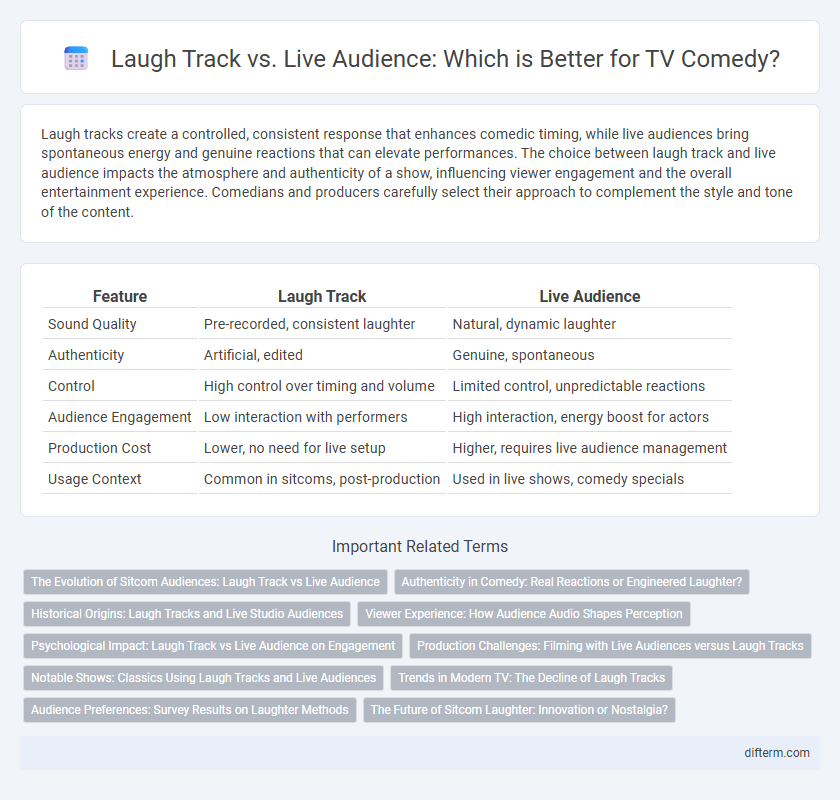Laugh tracks create a controlled, consistent response that enhances comedic timing, while live audiences bring spontaneous energy and genuine reactions that can elevate performances. The choice between laugh track and live audience impacts the atmosphere and authenticity of a show, influencing viewer engagement and the overall entertainment experience. Comedians and producers carefully select their approach to complement the style and tone of the content.
Table of Comparison
| Feature | Laugh Track | Live Audience |
|---|---|---|
| Sound Quality | Pre-recorded, consistent laughter | Natural, dynamic laughter |
| Authenticity | Artificial, edited | Genuine, spontaneous |
| Control | High control over timing and volume | Limited control, unpredictable reactions |
| Audience Engagement | Low interaction with performers | High interaction, energy boost for actors |
| Production Cost | Lower, no need for live setup | Higher, requires live audience management |
| Usage Context | Common in sitcoms, post-production | Used in live shows, comedy specials |
The Evolution of Sitcom Audiences: Laugh Track vs Live Audience
Sitcoms have evolved from relying heavily on laugh tracks, artificial audio cues designed to simulate audience laughter, to embracing live audiences that provide genuine, spontaneous reactions, enhancing the viewing experience's authenticity. The transition emphasizes increased audience engagement and realism, with shows like "Friends" and "The Big Bang Theory" showcasing the energy of live laughter impacting comedic timing and actor performances. Modern productions balance these approaches using advanced sound mixing technologies to preserve natural ambiance while managing production constraints.
Authenticity in Comedy: Real Reactions or Engineered Laughter?
Authenticity in comedy hinges on whether laughter is genuine or manufactured, with live audiences providing spontaneous reactions that enhance the realism of comedic timing. Laugh tracks, while engineered to cue viewers on when to laugh, often create a polished but artificial ambiance that can diminish the organic energy of a live performance. Audience engagement and authentic response are critical factors that influence the perceived quality and emotional impact of comedy shows.
Historical Origins: Laugh Tracks and Live Studio Audiences
Laugh tracks originated in the 1950s as a technical solution to enhance sitcoms by adding prerecorded laughter to mimic a live audience's response. Live studio audiences have roots in early radio and television, where real-time audience reactions provided authentic engagement and influenced performers' timing. This distinction shaped the evolution of sitcom production, balancing controlled soundscapes with genuine viewer interaction.
Viewer Experience: How Audience Audio Shapes Perception
Laugh tracks create a controlled and consistent atmosphere that guides viewers' emotional responses, often enhancing comedic timing and signaling humor cues. In contrast, a live audience generates spontaneous reactions, adding authenticity and energy that can make performances feel more engaging and dynamic. The presence and style of audience audio significantly influence how viewers perceive the humor, pacing, and overall enjoyment of entertainment content.
Psychological Impact: Laugh Track vs Live Audience on Engagement
Laugh tracks create a consistent auditory cue that can enhance viewers' perception of humor, potentially increasing engagement by signaling when to laugh. Conversely, a live audience provides genuine, spontaneous reactions that foster a more authentic and immersive viewing experience, strengthening emotional connection and social bonding. Studies show that live audience feedback can elevate viewers' psychological involvement, making content feel more dynamic and engaging compared to the artificial nature of laugh tracks.
Production Challenges: Filming with Live Audiences versus Laugh Tracks
Filming with live audiences demands precise timing and multiple takes to capture genuine reactions, often extending production schedules and incurring higher costs. In contrast, laugh tracks offer flexibility by allowing editors to insert canned laughter during post-production, streamlining filming but risking unnatural audience perception. Balancing authentic viewer engagement against logistical efficiency remains a core production challenge in comedy entertainment.
Notable Shows: Classics Using Laugh Tracks and Live Audiences
Classic sitcoms such as "Friends" and "The Big Bang Theory" utilized live audiences to capture authentic laughter and enhance comedic timing. In contrast, iconic shows like "The Flintstones" and "I Love Lucy" relied on laugh tracks to simulate audience reactions, ensuring consistent humor cues across episodes. This distinction highlights how production choices impact viewer engagement and the overall entertainment experience.
Trends in Modern TV: The Decline of Laugh Tracks
Modern TV trends reveal a significant decline in the use of laugh tracks as viewers increasingly prefer authentic reactions over canned laughter. Streaming platforms and single-camera sitcoms emphasize genuine moments, contributing to the diminished reliance on laugh tracks. Live audiences remain popular for capturing spontaneous energy but are less common in scripted series that favor naturalistic soundscapes.
Audience Preferences: Survey Results on Laughter Methods
Survey results show a growing preference for live audience laughter over laugh tracks, with 68% of viewers finding genuine reactions more enjoyable and relatable. Data indicates that programs featuring live audience responses experience higher viewer engagement and perceived authenticity. Insights from Nielsen ratings reveal that shows without artificial laughter maintain stronger audience retention and satisfaction metrics.
The Future of Sitcom Laughter: Innovation or Nostalgia?
Sitcoms harness the distinct energy of live audiences to capture authentic laughter that enhances comedic timing, while laugh tracks offer controlled and consistent audience reactions that streamline production. Emerging technologies like AI-driven laugh modulation and immersive virtual audiences present innovative methods to merge spontaneity with precision, potentially redefining how sitcom humor is experienced. Balancing nostalgia for traditional laughter cues with the demand for dynamic viewer engagement will shape the future landscape of sitcom entertainment.
laugh track vs live audience Infographic

 difterm.com
difterm.com